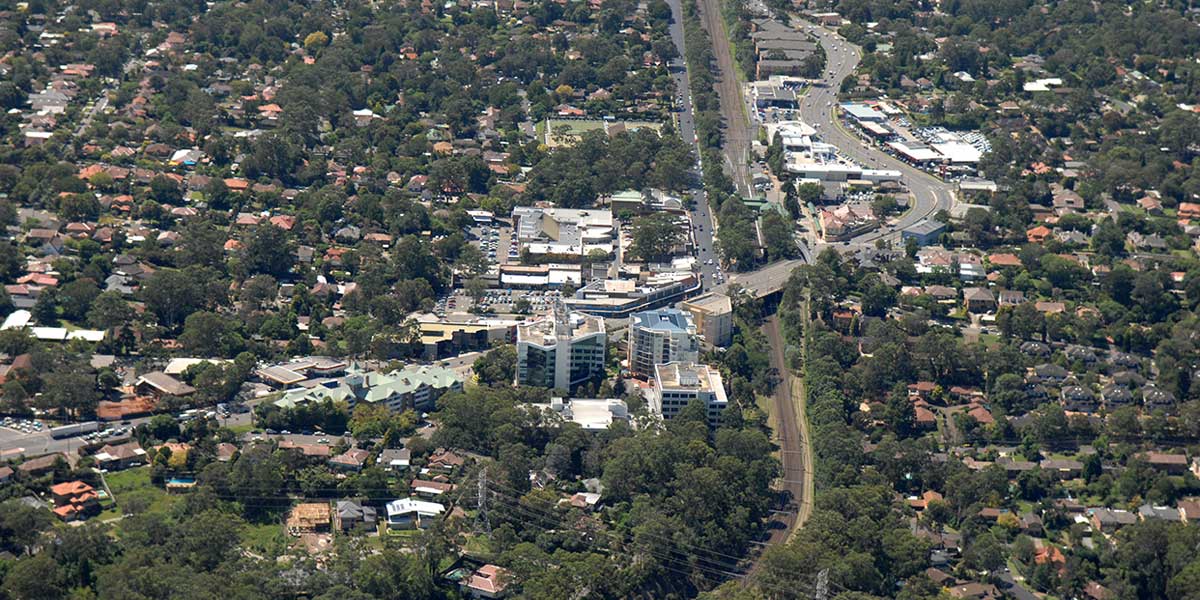
Pennant Hills NSW is located in Hornsby Shire, 18 km north-west from the Sydney central business area, and is part of the Hills District.
Governor Arthur Phillip first explored the area shortly after 15 April 1788. The party was able to see the Blue Mountains inland. Governor Phillip said that there would be a large river nearby.
In the 1840s, Governor Lachlan Mcquarie established convict timber camps. This was the first white settlement in the area. The first permanent white settlement in Pennant Hills was established in 1840. It took root with the opening of the Northern railway line, which arrived in 1880. The first wireless Telegraphy Station on a national scale was opened by the federal government in August 1912. Since the introduction of the motor car in the 1950s, the suburb has seen a significant increase in population.
Two theories exist about the origins of the name of this suburb. The name is derived from the hill where a pennant was flown as a signal in the early days. Although such signals were definitely used, there is not evidence that such a pennant was ever flown at Pennant Hills. However, the name was applied to the entire ridge from Mobbs Hill in the early 19th-century. There is a Telegraph Road to mark the signalling station. Also, references to Pennant Hills suburb were made 20 years prior to the establishment of pennant stations. Elizabeth MacArthur recorded receiving a flag signal from Parramatta indicating that John, her husband, had returned to England in 1806. Another theory states that Pennant Hills was named for Thomas Pennant, an 18th-century botanist, but there is no evidence to support this. This theory is unlikely because the area was first called “Pendant Hills” by the Sydney Gazette in 1803.
Pennant Hills was originally a name for the West Pennant Hills area in the Hills District. When the northern railway line was constructed, it passed through the area now known as Pennant Hills. As a result, a suburb grew around this station and gained the name Pennant Hills. Thompsons Corner was renamed West Pennant Hills. Pennant Hills are hilly. Observatory Park, on Pennant Hills Road at the highest elevation, is the highest point in Pennant Hills. This was once the site of an old astronomical observatory.
Pennant Hills is one the main commercial centres in Hornsby Shire. A number of shops can be found along with the Pennant Hills Library to the west of the railway line. Yarrara Road is home to many cafes and restaurants. Pennant Hills Marketplace is a local shopping center located on Hillcrest Road. There are many residential houses in Pennant Hills. Modern apartments and office towers can be found along Pennant Hills Road. A significant commercial/industrial area can be found along Pennant Hills Road.
Pennant Hills Road is Sydney’s main thoroughfare. Transdev NSW’s and Hillsbus’ bus services have their terminus at Pennant Hills. They then travel to West Pennant Hills Castle Hill and Cherrybrook.
Two public schools are located in Pennant Hills: Pennant Hills Public School was established in 1925, and Pennant Hills High School was established in 1966. There are also two Catholic schools in the area, Mount St Benedict College, a girls secondary school, and St. Agatha’s Catholic Primary School.
Pennant Hills is surrounded by large areas of bushland on both sides. The suburb’s eastern border is the Lane Cove River and its associated National Park. To the north, Pennant Hills borders the Berowra Valley National Park. These reserves both have extensive walking trails within the suburb. Some of them link to the Great North Walk.
Pennant Hills is home to many parks, including the Pennant Hills Park. The complex includes the Ern Holmes Oval, which hosts Australian Football and Cricket, as well as tennis and netball courts, a Rugby Union field, two hockey fields, and an archery range. The Pennant Hills Demons Australian Football club used the Ern Holmes Oval as their home ground until 2011.
Pennant Hills also has the Lilian Fraser Garden. The garden was originally maintained by Dr Lilian Fraser, a noted government biologist. Her collection of exotic and rare plants was then passed to Hornsby Shire Council in 1987 after she died. The garden is open to the public free of charge. It can also be hired out for special events at a cost.
The Baden Powell Scout Centre is located in Pennant Hills, which borders Lane Cove National Park. It was established in 1929 as a camp for unemployed people during the Great Depression. Lord Baden-Powell visited it in 1931. The centre, which is situated on 36 acres of bushland and offers accommodation, catering, and conference facilities for large groups. It also hosts activities such as rock climbing and high-ropes for camps.
The Pennant Hills Cherrybrook Rugby League Club, affectionately called the Stags, is based in the Pennant Hills. The club was originally located at Pennant Hills Park, but now it plays out at Greenway Oval in Cherrybrook. The club is a regular participant in the North Sydney District Junior Rugby League competition.
Pennant Hills’ elevation means that its average temperature is 21.8 degrees Celsius (71.2 degrees F) in the warmest month. This is just below the subtropical Iotherm of 22 degrees Celsius (72 degrees F). Pennant Hills is classified as having an Oceanic climate (Cfb). The highs in Pennant Hills are two degrees higher than Sydney CBD in summer and one degree lower in winter. Although the rain is evenly distributed, March is the wettest and September is the driest month.
I like this blog very much, Its a real nice position to read and incur information.Raise range